Communion on by the tongue…
Priestly Fraternity of St. Peter offers
sacrilegious “Lick-Off Communion” in Germany
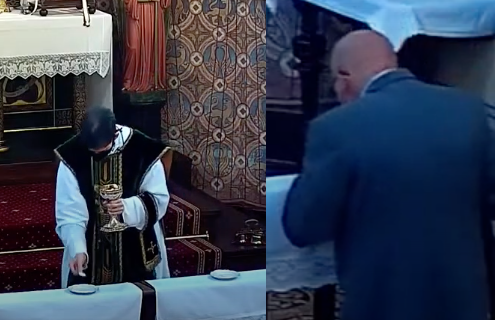
On Sep. 15, 2020, people at St. Peter Canisius’ self-communicated by licking hosts off saucers
In the German town of Saarlouis, the Priestly Fraternity of St. Peter (FSSP) has its own parish, the Church of St. Peter Canisius. In terms of externals, it is absolutely gorgeous. The pastor there is “Fr.” Christoph Fuisting.
However, as an organization that prides itself on supposedly retaining Catholic Tradition, what took place there on Sep. 13, 2020 (Fifteenth Sunday after Pentecost), defies belief.
As reported by the well-informed and highly-reliable Novus Ordo journalist Giuseppe Nardi, “Fr.” Fuisting refuses to administer Holy Communion on the tongue on account of the (real or alleged) Coronavirus threat. Instead, he puts little plates or saucers on the Communion rail, each several feet apart. After the Domine non sum dignus, he proceeds to place one host on each plate and returns to the altar. His instruction to the people, according to Nardi, is: “The Blessed Sacrament is to be picked up off the little plate by the tongue” (Das Allerheiligste wird mit der Zunge vom Tellerchen aufgenommen).
That is precisely what happened yesterday. The people began to kneel down at the Communion rail, bent down as needed (some picking up the saucer a bit), and licked the host off the plate — like dogs. Afterwards, they returned to their pews. Then the celebrant came, took the little plates away (stacking them on top of one another), and distributed new ones. The undignified spectacle was repeated, as there were more people wishing to receive.
Don’t believe it? See below for some images, which are screenshots taken from the video. Although no licking is actually visible, as the camera always carefully avoided showing precisely that action, it is clear that that is what was taking place.
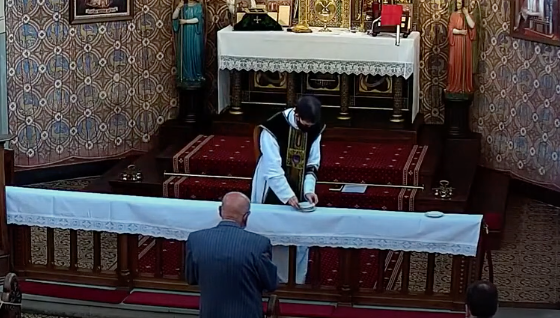
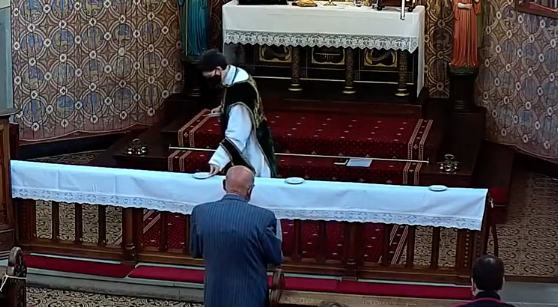
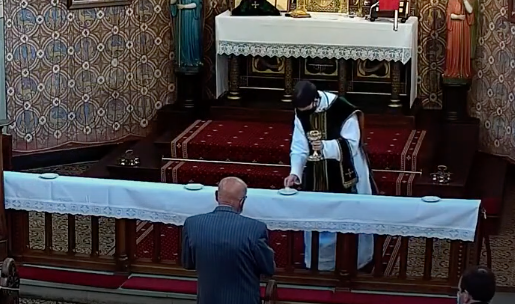
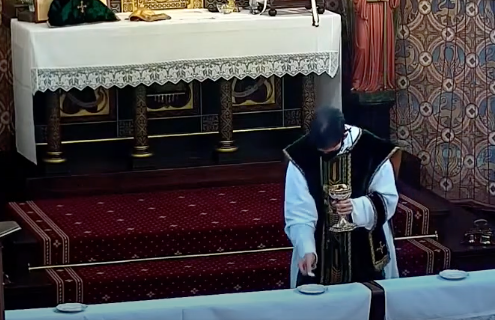
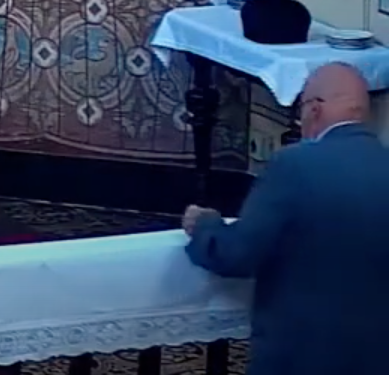
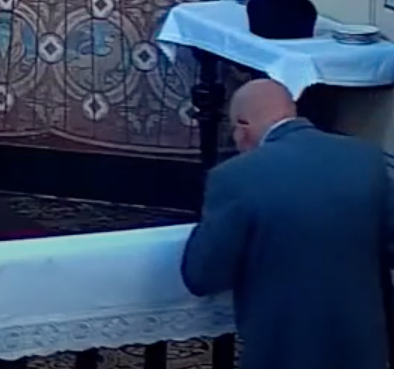
The full video can be watched below. The distribution of “Communion” takes place after the “Mass”, beginning at the 1:06:40 mark.
A priest has to purify his paten at the altar over the chalice to ensure no fragments of the Blessed Sacrament remain. Which raises the question: What happened to the stack of used saucers after the unworthy spectacle? They were certainly not purified at the altar. Did they receive special hazmat treatment because of Coronavirus?
We must also point out that in addition to the obvious sacrilege of receiving “Communion” the way animals lick food off plates, this horrific practice amounts to self-communication, meaning that the communicant administers Holy Communion to himself. Self-communication is ordinarily only permitted to priests, not to the laity (see Fr. Nicholas Halligan, The Administration of the Sacraments [Cork: The Mercier Press, 1963], pp. 107-108).
The Fraternity of St. Peter is an offshoot of the Society of St. Pius X (SSPX). When in 1988, Abp. Marcel Lefebvre consecrated four bishops against the explicit prohibition of “Pope” John Paul II, a number of their priests refused to follow him in his schism from the Vatican II Church and instead took John Paul up on his offer of joining a new priestly society dedicated to offering the Traditional Latin Mass, but in “full communion” with the “Pope”.
Those SSPX priests that left in 1988 and joined the newly-founded FSSP, are naturally valid priests. However, any new ordinations done for the FSSP, although administered in the traditional rite, were always conferred by Novus Ordo bishops, that is, bishops themselves consecrated in the invalid 1968 rite of “Pope” Paul VI. For that reason, almost all FSSP priests around the world are invalid.
So, there is a bright spot in this after all: The “Mass” and “Communion” at St. Peter Canisius’ were in fact invalid.
The scandal, however, remains.

“Give not that which is holy to dogs…” (Mt 7:6)
Image sources: youtube.com (screenshots) / shutterstock.com
Licenses: fair use / paid



No Comments
Be the first to start a conversation